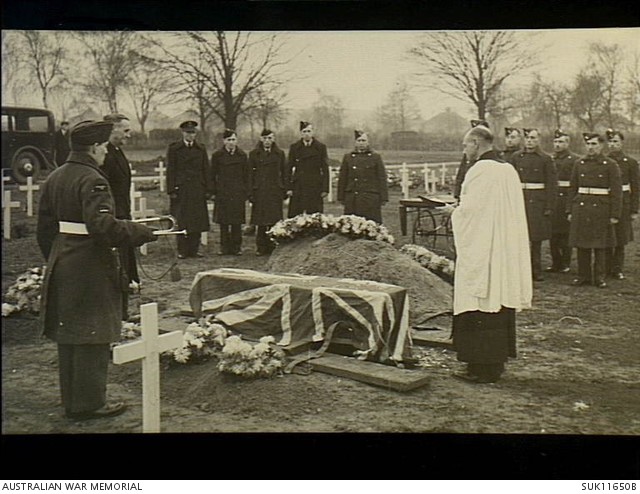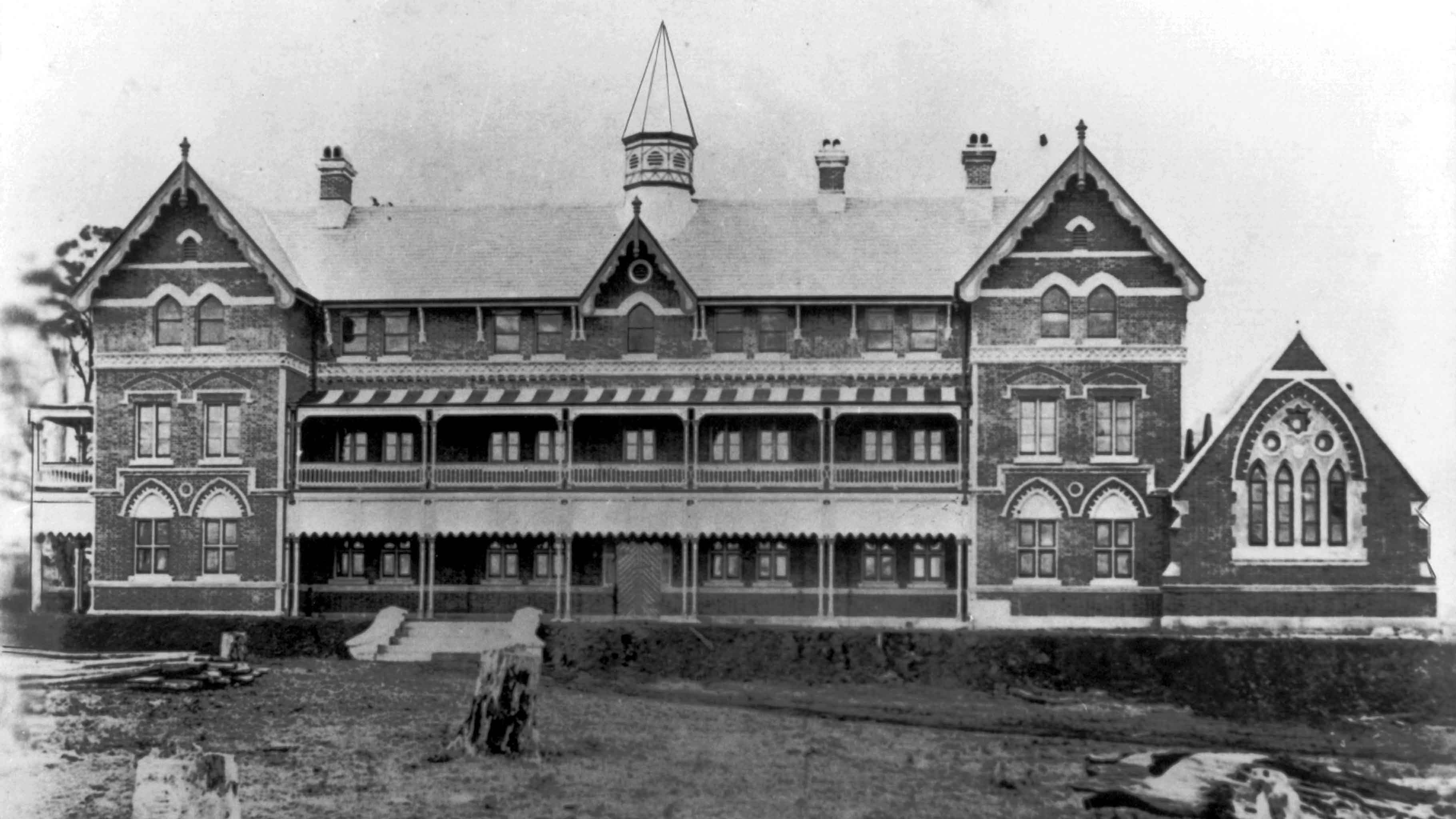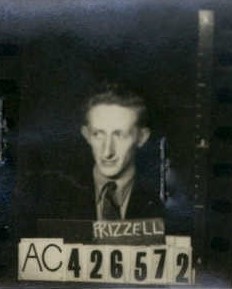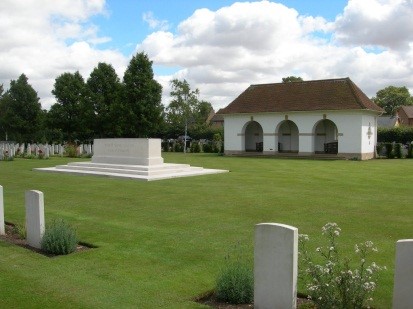Flight Sergeant Cecil Roland Frizzell, the son of John Roland Hyland Frizzell and Ursula Marie Frizzell (nee Ward), was born at Toowoomba in Queensland on 12th May 1923. Flight Sergeant Cecil Frizzell was educated at the Southbrook (Harlemar) School during the period 1928 until 1936. He then attended The Toowoomba Grammar School during the years 1936 until 1939 where he passed the Queensland University Junior Public Examination. Whilst a student at the Grammar School he had served in the School’s Cadet Unit. After leaving school he was employed at Cliff Smith, Commission Agent at Pittsworth for six months and then he was employed at the Toowoomba Foundry Sales Office as a Clerk. He applied for aircrew training in the Royal Australian Air Force on 10th December 1941. He was enrolled in the Reserve of the R.A.A.F. on 30th December 1941 after swearing an oath of allegiance.
Flight Sergeant Cecil Frizzell at the age 19 years and 1 month was enlisted in the Citizen Air Force of the R.A.A.F. at No. 3 Recruiting Centre in Brisbane on 18th July 1942 after giving an undertaking that he would serve for the duration of the war and an additional twelve months. His physical description at the time of enlistment was that he was 5 feet 6 inches in height and weighed 112 pounds. He had a fair complexion, grey eyes and light brown hair. He stated that he was of the Church of England Religion. He gave his next of kin as Mr John Roland Frizzell, residing at “Sunnyside”, Southbrook, via Toowoomba.
Flight Sergeant Cecil Frizzell was allotted the service number of 426572 and he joined No. 3 Initial Training School at Kingaroy in Queensland on 18th July 1942 where he was taught the basics of military discipline and the basics of military aviation. After completing his initial training he was selected for training as an Air Gunner. He joined No. 3 Wireless & Gunnery School at Maryborough in Queensland on 15th October 1942. He joined No. 1 Bombing & Gunnery School at Evans Head in New South Wales on 8th March 1942. After qualifying as an Air Gunner at Evans Head he was awarded the Air Gunner Qualification Badge and promoted to the rank of Temporary Sergeant on 1st April 1943. He joined No. 3 Embarkation Depot at Sandgate on 2nd April 1943 and No. 2 Embarkation Depot at Bradfield Park in New South Wales on 23rd April 1943 to prepare for overseas attachment to the Royal Air Force. He embarked from Brisbane in Queensland on 5th May 1943 and disembarked in England on 6th July 1943 where he joined No. 11 Personnel Despatch & Reception Depot at Bournemouth on the following day.
Flight Sergeant Cecil Frizzell joined No. 27 Operational Training Unit at Royal Air Force Station Lichfield on 27th July 1943 where he was trained for night bombing on Vickers Wellington aircraft. He joined No. 1661 (Heavy) Conversion Unit at Royal Air Force Station Winthorpe on 4th September 1943. He joined No. 467 Squadron Royal Australian Air Force at Royal Air Force Station Waddington for operational duty on 23rd October 1943.
Flight Sergeant Cecil Frizzell was an Air Gunner and member of the crew of a No. 467 Squadron Royal Australian Air Force Lancaster Bomber JB 140. It crashed at Royal Air Force Station, Waddington, Lincolnshire, on 4th December 1943 after taking off on an operational sortie. He received severe lacerations to his head and suffered a fractured skull. He died of his injuries the following day at the Royal Air Force Hospital at Rauceby in the United Kingdom. He was laid to rest in the Cambridge City Cemetery in the United Kingdom with full military honours at 1500 hours on Thursday, 9th December 1943. At the time of his death Cecil Frizzell was twenty years of age.
An investigation was conducted into the crash and the following report was provided by the pilot:
On the night of 3/4th December 1943 I was detailed to attack Leipzig. Before take off I did the normal ground run and was completely satisfied with the four engines of the aircraft. At approximately 10 minutes before take-off time I started all four engines and taxied out to take off. I had just become airborne when a violent swing to port developed and on hearing the Bomb Aimer say “Your lights have come on, Bill” to the Engineer, I realised that the two port engines had cut. Suddenly, however, these engines picked up again (I learned later that the Engineer changed from No. 2 to 1 tanks) but they cut for the second time and I endeavoured to crash land in a field ahead. I was able to stall the aircraft on to the ground and before leaving switched off all fuel cocks and ignition switches, and on seeing my crew leaving ordered them well away in case the bomb load exploded. I was successful in kicking away some burning incendiaries from near the aircraft and assisted in carrying the unconscious Rear Gunner (Cecil Frizzell) well away from the scene. I then went to the Flying Control to report the accident.
Cecil Frizzell’s name is commemorated on Panel No. 110 at the Australian War Memorial in Canberra and locally on the Toowoomba Mothers’ Memorial, the Toowoomba Soldiers’ Memorial Hall Honour Board, the Pittsworth Honour Board, the Dalby Honour Stone and the Toowoomba Grammar School World War 2 Honour Board.
His photograph and the following details of his death were published in the Toowoomba Chronicle on 18th December 1943:
Mr and Mrs J.R.H. Frizzell, of “Sunnyside”, Southbrook, have received word from the Minister of Air that their son, Flight Sergeant Wireless Air Gunner Cecil Ronald Frizzell, has died of injuries received when the Lancaster bomber in which he was a member of the crew crashed when taking off on an operational sortie. Flight Sergeant Frizzell received head injuries and was admitted to a Royal Air Force hospital where he died the following day (December 5). He had taken part in a raid on Berlin on the night of November 26. Flight Sergeant Frizzell, who was 20 years of age, was educated at the Toowoomba Grammar School, and was employed in the sales office of the Toowoomba Foundry prior to enlisting two years ago. Mr and Mrs Frizzell recently were advised that another son had completed his training overseas and had received his wings and a commission.
Toowoomba Grammar School records show that he enrolled as a boarder on 1st February 1938 and that he left the School on 5th April 1940. His parent was shown as John Roland Hyland Frizzell, “Sunnyside”, Southbrook. He passed 7 subjects in the Junior examination in 1939. After leaving school he was employed as an Accountant at the Toowoomba Foundry.

Australian War Memorial photograph SUK11650B
A prayer being offered at the funeral service for Flight Sergeant Cecil Roland Frizzell at Waddington in England.




